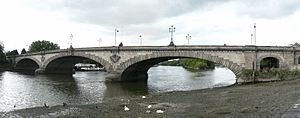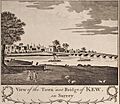Kew Bridge facts for kids
Quick facts for kids Kew Bridge |
|
|---|---|

The current (third) Kew Bridge
|
|
| Carries | A205 road |
| Crosses | River Thames |
| Locale | Kew |
| Maintained by | Transport for London |
| Heritage status | Grade II listed structure |
| Characteristics | |
| Design | Arch |
| Material | Granite |
| Total length | 1,182 feet (360 m) |
| Width | 75 feet (23 m) |
| Longest span | 133 feet (41 m) |
| Number of spans | 3 |
| Piers in water | 2 |
| History | |
| Designer | John Wolfe-Barry and Cuthbert A Brereton |
| Opened | 20 May 1903 |
| Statistics | |
| Toll | Abolished 8 February 1873 |
Kew Bridge is a famous bridge that crosses the River Thames in London. It connects two areas: Kew (in the Richmond upon Thames) and Brentford (in the Hounslow). The bridge you see today was opened in 1903 by King Edward VII and Queen Alexandra. It was designed by John Wolfe-Barry and Cuthbert A Brereton. This bridge is so important that it's a Grade II listed structure, meaning it's protected for its history and special design.
Contents
Where is Kew Bridge?
Kew Bridge is located in west London. It connects Kew Green on the south side of the river with Brentford on the north side.
On the Kew side, the bridge is right next to the famous Kew Gardens. On the Brentford side, it's near the London Museum of Water & Steam.
This bridge is a very busy road. It helps connect major roads around London. Near the bridge on the Kew side, you'll find Kew Pier. This is where tourist boats pick up and drop off passengers.
The Story of Kew Bridge
Kew Bridge has a long history, with three different bridges built in the same spot!
The First Kew Bridge (1759-1789)
The very first bridge at Kew was built by Robert Tunstall from Brentford. Before the bridge, he owned the ferry service that crossed the river here.
The first bridge opened on June 1, 1759. George, Prince of Wales (who later became King George III) and his mother, Augusta, were there for the opening. Three days later, it opened to everyone. Over 3,000 people crossed it on the first day!
This bridge had two stone arches at each end. In the middle, it had seven wooden arches. Wooden arches were hard to keep in good shape, so this bridge only lasted about 30 years. People had to pay a small fee, called a toll, to cross the bridge.
The Second Kew Bridge (1789-1903)
Because the first bridge was costly to fix, a new one was planned. Robert Tunstall's son got permission to build a replacement. Work started on June 4, 1783.
The new bridge was designed by James Paine. He had also designed Richmond Bridge. This second bridge was built entirely of stone. It was opened on September 22, 1789, by King George III himself.
This bridge was built right next to the first one. This meant people could still cross the river while the new bridge was being built. The second bridge was much stronger and lasted for over 100 years.
The tolls for crossing the bridge were removed on February 8, 1873. To celebrate, a special arch was built at the Brentford entrance. The old toll gates were taken down and paraded through the streets!
The Third (Current) Kew Bridge (1903-Today)
By the 1890s, the second bridge was no longer big enough for all the traffic. It was also too narrow and steep on the Brentford side. So, engineers decided a brand new bridge was needed.
The third Kew Bridge was designed by Sir John Wolfe Barry and Cuthbert A Brereton. It cost a lot of money, about £250,000 at the time. The building contractors were Easton Gibbs and Son.
This new bridge is much bigger. It is 1,182 feet (360 meters) long. The widest of its three arches spans 133 feet (41 meters). The roadway is 56 feet (17 meters) wide, and the sidewalks are 9 feet 6 inches (2.9 meters) wide. It was built using strong granite stone.
Before the old bridge was taken down, a temporary wooden bridge was put in place. This allowed people to keep crossing the river. The third bridge was finished and officially opened on May 20, 1903. King Edward VII and Queen Alexandra came for the special ceremony.
A large tent was set up on the bridge for the opening. The King laid the very last stone with a silver trowel. He then declared the bridge officially open! The King and Queen received many gifts, including a history book about the bridge and even an ancient flint axe found during construction. After the ceremony, a huge party was held at Kew Gardens. One thousand children enjoyed tea in a big tent on Kew Green.
Kew Bridge in Art
Kew Bridge has been a popular subject for artists over the years.
- A drawing from 1759 by Paul Sandby shows the first Kew Bridge.
- James Webb painted Old Kew Bridge, London between 1876 and 1885.
- Henry Muhrman painted Kew Bridge around 1898. This painting is now in the Tate Gallery.
- The Tate also has sketches and paintings of the Thames at Kew by J. M. W. Turner.
- Myles Birket Foster painted Kew Bridge from Strand on the Green.
- Lewis Pinhorn Wood painted Arrival of a Steamer at the Old Kew Bridge. This painting shows people getting on a boat at Kew Pier.
Images for kids
-
Kew Pier is a few metres downstream of Kew Bridge
See also
- Crossings of the River Thames
- Kew Bridge railway station
- List of bridges in London






